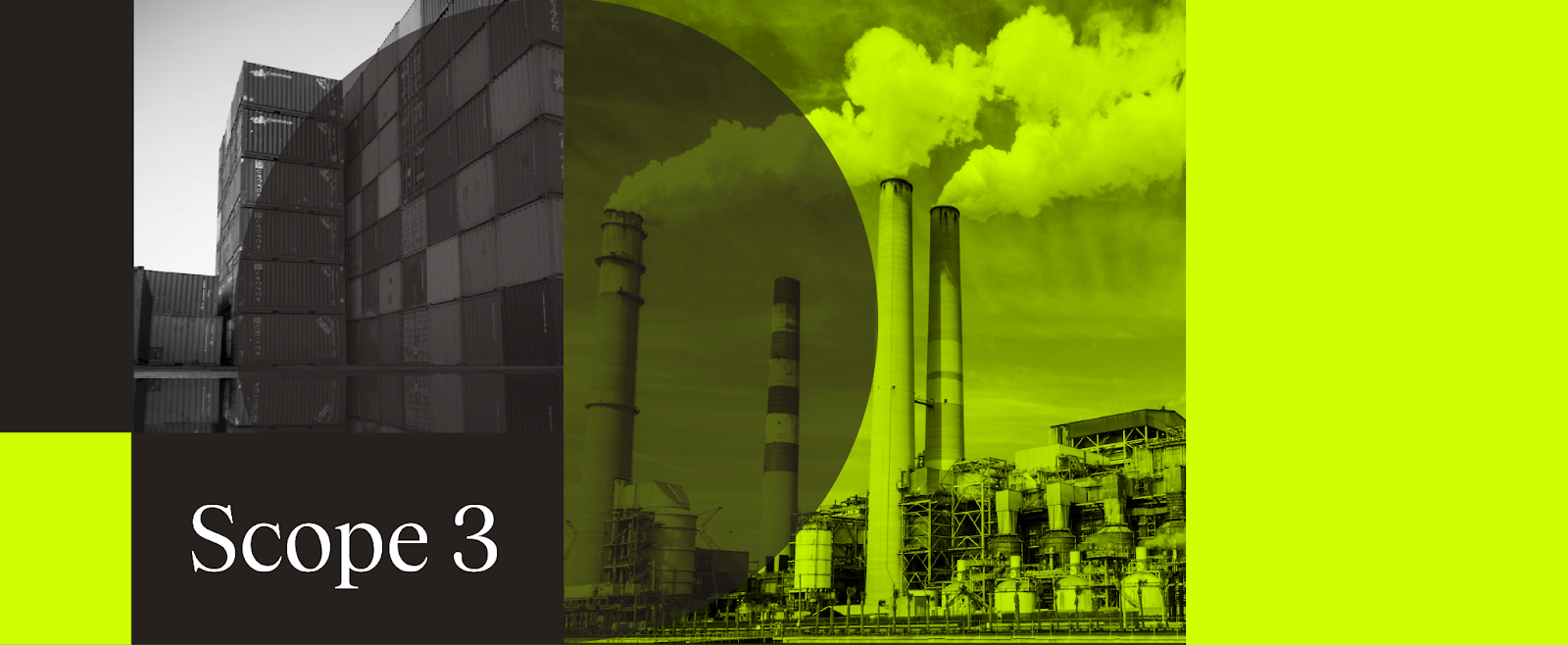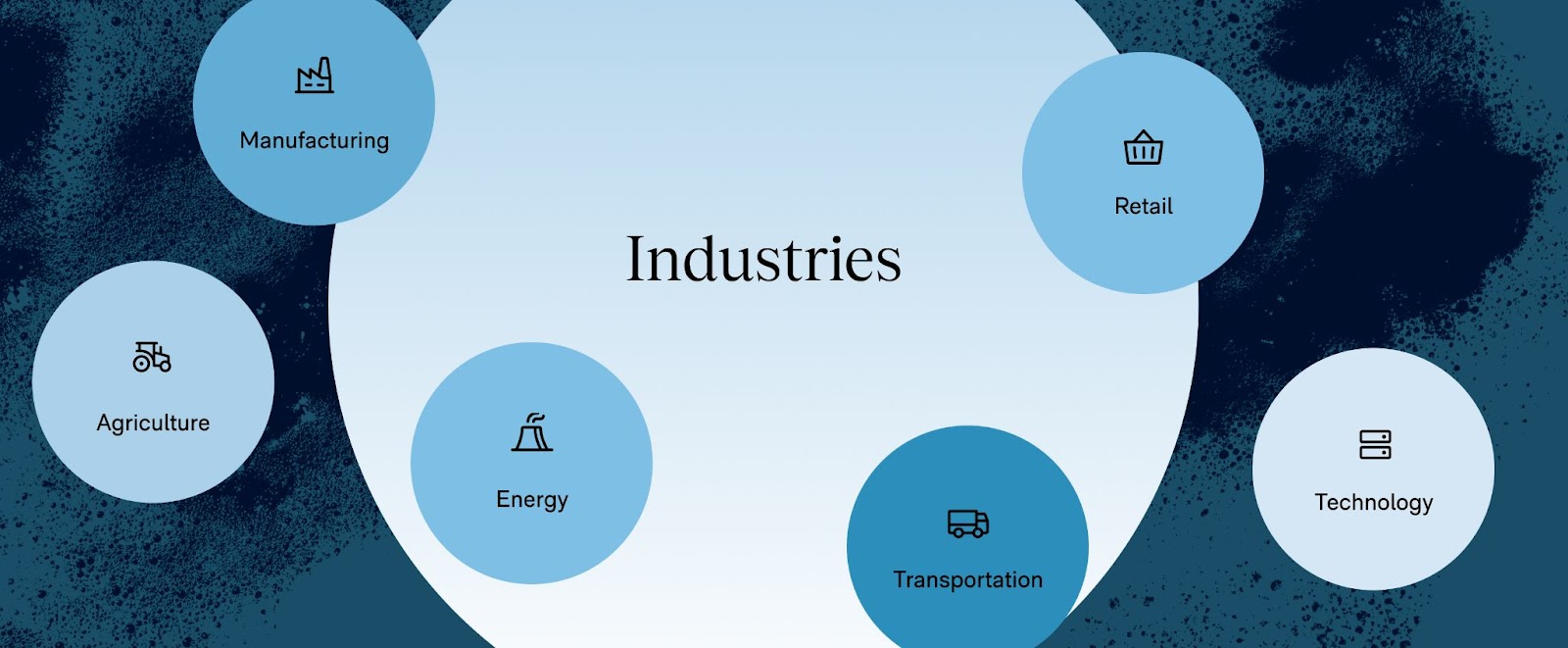In today's world, addressing climate change is crucial, and businesses are at the heart of this effort. The carbon your business emits, the energy it uses, and the products it develops contribute significantly to its carbon footprint.
In a world where performance on ESG metrics like carbon emissions increasingly drives investment decisions, compliance, and consumer trust, it is now a strategic business need to understand and manage supply chains and reduce this impact.
What exactly is a Corporate Carbon Footprint?

A Corporate Carbon Footprint (CCF) is an accounting of the total greenhouse gas (GHG) emissions resulting from a company's direct and indirect business activities. This encompasses not only carbon dioxide (CO2) but also other greenhouse gases like methane (CH4) and nitrous oxide (N2O). For ease of understanding, carbon accountants convert the global warming impact of these gases into carbon dioxide equivalent (CO2e) utilizing conversion factors from the IPCC.
Calculating a CCF is often the first step toward achieving meaningful emission reductions across a business, as it identifies emissions hotspots within operations, helping to pinpoint areas that require reduction efforts. Life Cycle Assessment (LCA) is used to calculate product-level carbon footprints and other environmental impact footprints, and its data across multiple LCA impact categories can inform CCFs when aggregated across a company’s value chain.
To bolster credibility and improve comparability over time and against other companies, the overwhelming majority of businesses deploy a standardized accounting approach called the Greenhouse Gas (GHG) Protocol, which divides emissions into three emission Scopes for ease of understanding and analysis.
Breaking down the Scopes to understand emissions sources
To manage emissions effectively, the GHG Protocol classifies corporate emissions into three scopes: Scope 1, Scope 2 and Scope 3. This framework allows companies to differentiate between emissions under their direct control and those that result indirectly from their activities. The GHG Protocol provides standards, tools, and training for accurate impact measurement and management.
Scope 1: Direct emissions
Scope 1 emissions come directly from company-owned or controlled sources.
Common sources include:
- On-site fuel combustion (e.g., natural gas in boilers).
- Fuel combusted in company vehicles (e.g., delivery trucks).
- Industrial activities (e.g., cement production, metal smelting).
- Fugitive emissions like refrigerant leaks.
- Agricultural emissions (e.g., methane from livestock).
Scope 2: Indirect emissions from purchased electricity
Scope 2 emissions come from the consumption of purchased electricity, steam, heat, or cooling, even though the direct emissions from these sources occur at the site of generation (e.g., direct emissions from electricity occur at the power plants where fossil fuel energy is converted into electricity via combustion). Examples:
- Purchased electricity used in owned or controlled offices and factories.
- Purchased heating or cooling used in owned or controlled facilities.
The rationale for including these indirect emissions within their own scope is that although the emissions occur off-site, the company typically has the means to reduce this category of emissions, including changing electricity providers or tariffs or purchasing and retiring renewable energy credits (RECs).
Scope 3: All other indirect emissions

Scope 3 emissions encompass all other indirect value chain emissions not included in Scope 2.
For most companies that don’t directly own and control their supply chain, Scope 3 is the largest portion of their corporate carbon footprint. In some sectors, this can amount to over 99% of the total emissions.
Given the scale of Scope 3, further subcategorization is helpful to understand hotspots. One helpful way to categorize Scope 3 emissions is by whether they occur “upstream” or “downstream” in the value chain. The GHG Protocol uses this approach, and then further divides Scope 3 into 15 distinct categories as set forth below:
Upstream:
- Category 1: Purchased Goods and Services
- Category 2: Capital Goods
- Category 3: Fuel- and Energy-Related Activities (not included in scope 1 and scope 2)
- Category 4: Upstream Transportation and Distribution
- Category 5: Waste Generated in Operations
- Category 6: Business Travel
- Category 7: Employee Commuting
- Category 8: Upstream Leased Assets
Downstream:
- Category 9: Downstream Transportation and Distribution
- Category 10: Processing of Sold Products
- Category 11: Use of Sold Products
- Category 12: End-of-Life Treatment of Sold Products
- Category 13: Downstream Leased Assets
- Category 14: Franchises
- Category 15: Investments
Why should companies care about their carbon footprint?
Understanding and managing your business’s Corporate Carbon Footprint (CCF) is valuable for multiple reasons:
Climate impact
- GHG emissions cause climate change, which is already causing significant impacts to society and the environment.
- Tracking organization-level GHG emissions over time helps companies understand and identify areas to reduce their climate impact.
- Even companies that don’t directly release most of their emissions can play a pivotal role in the global transition to a net-zero economy.
Business benefits
- Identifying inefficiencies in terms of GHG emissions may simultaneously lead to cost savings and process optimization that benefit the business’s bottom line.
- Proactively measuring emissions may help to avoid greenwashing and the penalties associated with claims that are not backed by science.
- Key stakeholders like investors, customers, employees, and regulators increasingly expect transparency and credible action plans for managing and reducing emissions and climate risks.
Risk management
- Proactively assessing and managing organizational emissions helps companies navigate future risks such as supply chain disruptions in vulnerable areas and policy changes that favor lower-emitting technologies.
- ESG factors are increasingly considered by investors in investment and financing decisions, linking environmental performance to investment choices.
- Regulatory measures like the CSRD and California’s SB 253 mandate carbon footprint disclosure.
For these reasons, incorporating carbon footprint management into your sustainability strategy will not only drive climate impact reductions but is increasingly a strategic business practice essential for financial success over the next decades.
Corporate carbon footprints across industries with real-world examples

Evaluating corporate carbon footprints across industries reveals the diverse sources and magnitudes of emissions in different categories, reflecting their specific activities and the unique circumstances of their industry and demonstrating the case for sector-specific tooling.
Heavy manufacturing
In the manufacturing sector, organizational footprints primarily arise from the direct combustion of fossil fuel used to power machinery and generate heat. This sector also includes direct emissions from industrial processes, like the chemical reactions in cement production, which naturally release carbon dioxide. Yet substantial emissions may still originate from the supply chain, encompassing the extraction, production, and transportation of raw materials like metals and minerals.
Retail
The retail sector significantly contributes to global greenhouse gas emissions, depending on how it’s defined, as it spans the sale and use of virtually all products consumers purchase for end use, from food and furniture to electronics and automobiles. Notably, because retailers often buy and resell goods to consumers, their footprint is heavily dominated by Scope 3 emissions, which can constitute up to 98% of their carbon footprint. This makes it very challenging for retailers to decarbonize directly, but also means that retailers have a unique vantage point to drive and encourage reductions in their extended supply chains that span many industries.
Transportation
The transportation sector is a major emitter, with its carbon footprint primarily stemming from the combustion of fossil fuels in vehicles like cars, trucks, airplanes, and ships. Indirect emissions are also significant, arising from the energy required to manufacture vehicles and build transportation infrastructure, as well as upstream emissions generated in the extraction of combusted fuels. Logistics companies must manage emissions from fleet vehicles that burn gasoline and diesel, while the aviation industry's emissions derive largely from jet fuel consumption.
Agriculture
Agriculture's carbon footprint derives from many sources, including methane emissions from livestock, land use change emissions from the conversion of forests to agricultural lands, and nitrous oxide emissions from fertilizers used on agricultural soils. Indirect emissions come from the energy consumed in agricultural operations and the production of inputs like fertilizers. Methane emissions from cattle digestion are a familiar and significant issue within this sector.
Energy and electricity
The energy sector is the most significant source of GHG emissions, with direct fossil fuel combustion, refining, and electricity generation responsible for the lion’s share of global GHG emissions and underpinning the emissions profile of most other industries (e.g., transportation). Significant emissions also result from the processing of fuels (e.g., fugitive emissions from unintentional gas releases during fuel extraction and refining). A typical example is a coal-fired power plant, which directly emits large quantities of carbon dioxide into the atmosphere during combustion, but also accounts for upstream fuel extraction emissions.
Technology
Although often viewed as a "clean" industry, the technology sector has a notable carbon footprint as it relies on electricity. Direct emissions might be relatively lower, but indirect emissions are substantial, especially Scope 2 emissions from the vast electricity demands of data centers and Scope 3 emissions from consumer use. Similarly, the manufacturing of electronic devices and complex supply material-dependent supply chains result in significant Scope 3 emissions.
In summary, the significance of Scope 1, 2, and 3 emissions varies widely between industries. Understanding these variations is crucial to developing effective emission reduction strategies tailored to each industry's unique challenges and contributions.
Making sense of the numbers while calculating Corporate Carbon Footprints
The overwhelming majority of companies use the GHG Protocol to quantify their Corporate Carbon Footprint, which provides guidance on measuring and reporting GHG emissions across all scopes, offering a standardized method for accounting and reporting.
ISO 14064 similarly guides organizations in managing and verifying GHG emissions, ensuring data consistency and credibility.

The process of calculating a carbon footprint generally involves several key steps:
- Data collection: Gather information on activities that consume energy or resources, such as electricity, fuel, travel, and purchased goods. For Scope 3 emissions, this may require engagement with suppliers and partners.
- Emission factors: Use standardized values representing emissions for specific activities to convert activity data into CO2 equivalents. These factors, sourced from scientific research, are available through various databases.
- Tools and software: Many companies employ carbon footprint calculators and specialized software to automate data collection, perform calculations, and generate reports efficiently.
- Scope 3 methodologies: For Scope 3, companies typically use spend-based (financial data) or activity-based (specific activity data) methodologies, often deploying a combination of the two across various subcategories.
Following recognized standards like the GHG Protocol – the foundation of every emerging regulatory reporting obligation – is essential for achieving accurate and comparable results.
Taking action: The steps to reduce your Corporate Carbon Footprint
After a company assesses its Corporate Carbon Footprint, implementing reduction strategies is the logical next step. Here's how companies can effectively pursue reductions across all scopes:
Approach emission reductions strategically:
- Use granular data to pinpoint emissions hotspots
- Create strategies that actually reduce these emissions, using features like:
- Scenario modeling to forecast various impact reduction scenarios
- Targets to set and monitor Science Based Targets
- Prioritized reduction measures and supply chain funding
- Removals — many businesses:
- Invest in verified projects that remove or reduce greenhouse gases
- Use removal investments to complement but not replace reduction efforts.
Transition to renewable energy
- Convert to renewable and zero-emission tariffs from standard offers.
- Fund or install solar panels and wind turbines.
- Purchasing renewable energy certificates (RECs).
- Enter into corporate power purchase agreements (PPAs).
Support sustainable transportation
- Encourage remote work and the use of public transport or carpooling.
- Transition vehicle fleets to electric vehicles.
- Optimize logistics to reduce vehicle miles traveled.
Reduce waste and procure more sustainably
- Implement waste reduction and recycling programs within direct operations.
- Design products to incorporate recycled materials and that are optimized for recycling at end-of-life.
- Choose suppliers who have calculated their footprint and have targets in place to lower their GHG emissions.
It’s important to emphasize that reducing emissions at the source — before they have actually been created — is far more impactful than relying on retrospective carbon offsets for emissions that have already been generated.
Implementing these steps can lead to environmental benefits, cost savings, enhanced brand image and improved resilience for companies.
The role of technology: Measuring and reducing with innovation
Technology is increasingly valuable in helping companies measure, monitor, and reduce their Corporate Carbon Footprints. Advanced software platforms now automate complex data collection and emissions calculation across all scopes, offering comprehensive reporting. Innovations in Artificial Intelligence (AI) and machine learning provide sophisticated emission analysis and real-time insights for decision-making.
One example platform is Vaayu, designed for retailers to track and cut carbon emissions both at the organizational and product level.

Our purpose-built technology integrates with existing retail systems, automating environmental impact calculations in emissions, water use, and waste. Vaayu offers granular tracking, identifies high-impact areas, and provides personalized recommendations for emission reduction.
It uses a more accurate activity-based method for calculating Scope 3 emissions, tackling complex supply chains more effectively.
Technologies like Vaayu make carbon accounting more efficient, enabling proactive climate strategies based on precise, real-time data.
Managing a Corporate Carbon Footprint is now essential for responsible business in the 21st century.
Understanding what a CCF is, the emission scopes, and the reasons for corporate involvement reveals its substantial impact on both the environment and business success. While measuring and reducing it can be complex, frameworks and innovative technologies simplify the process.
As sustainability becomes increasingly important, addressing corporate carbon footprints is vital for businesses aiming for long-term viability and a lower environmental impact. Now is the time to leverage available resources and technology to pursue a sustainable future.
Vaayu brings deep expertise in Corporate Carbon Footprints (CCFs), helping retail businesses accurately measure and manage emissions across Scopes 1, 2 and 3. With TÜV-certified methodology and company-wide data integration, Vaayu empowers brands to quantify their Corporate Carbon Footprint, set credible reduction targets, comply with evolving regulations like CSRD and embed carbon intelligence into strategic decision-making. For expert support on all things Corporate Carbon Footprints and ESG, reach out to our expert team today.



.jpg)



.png)
.png)
